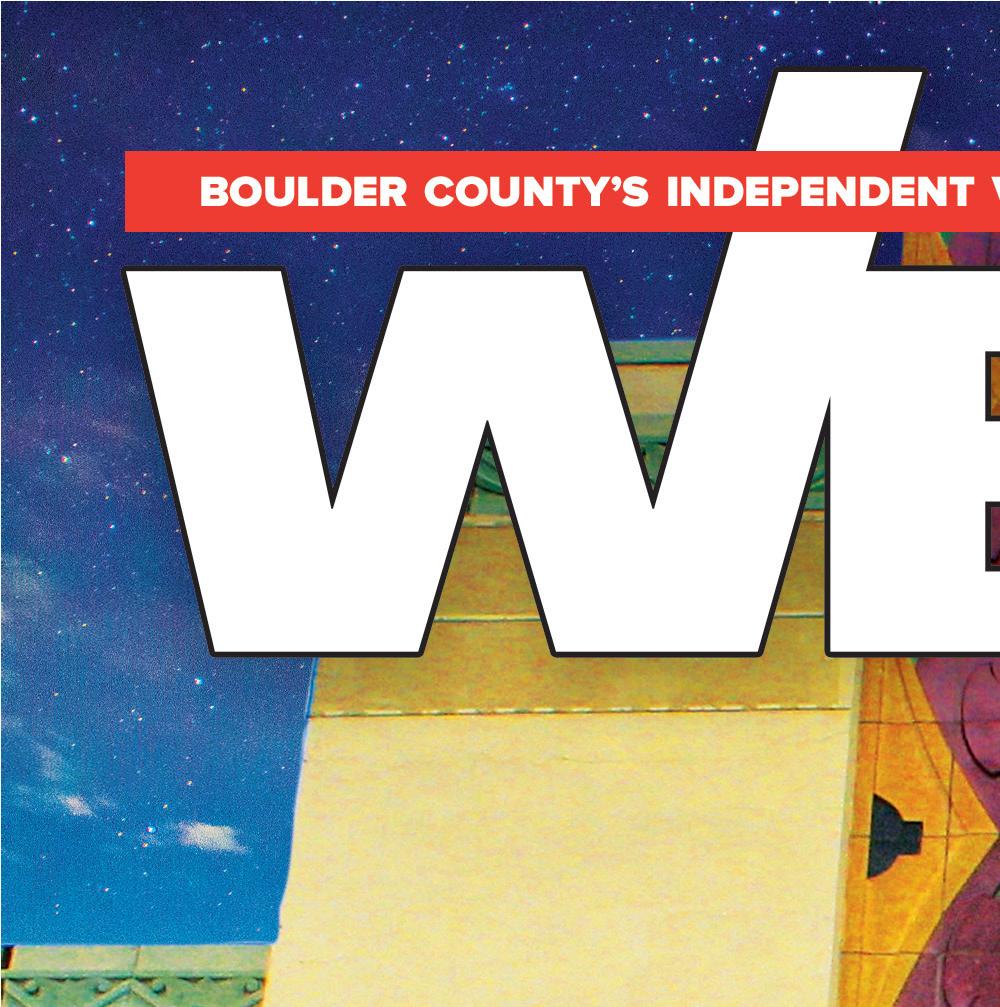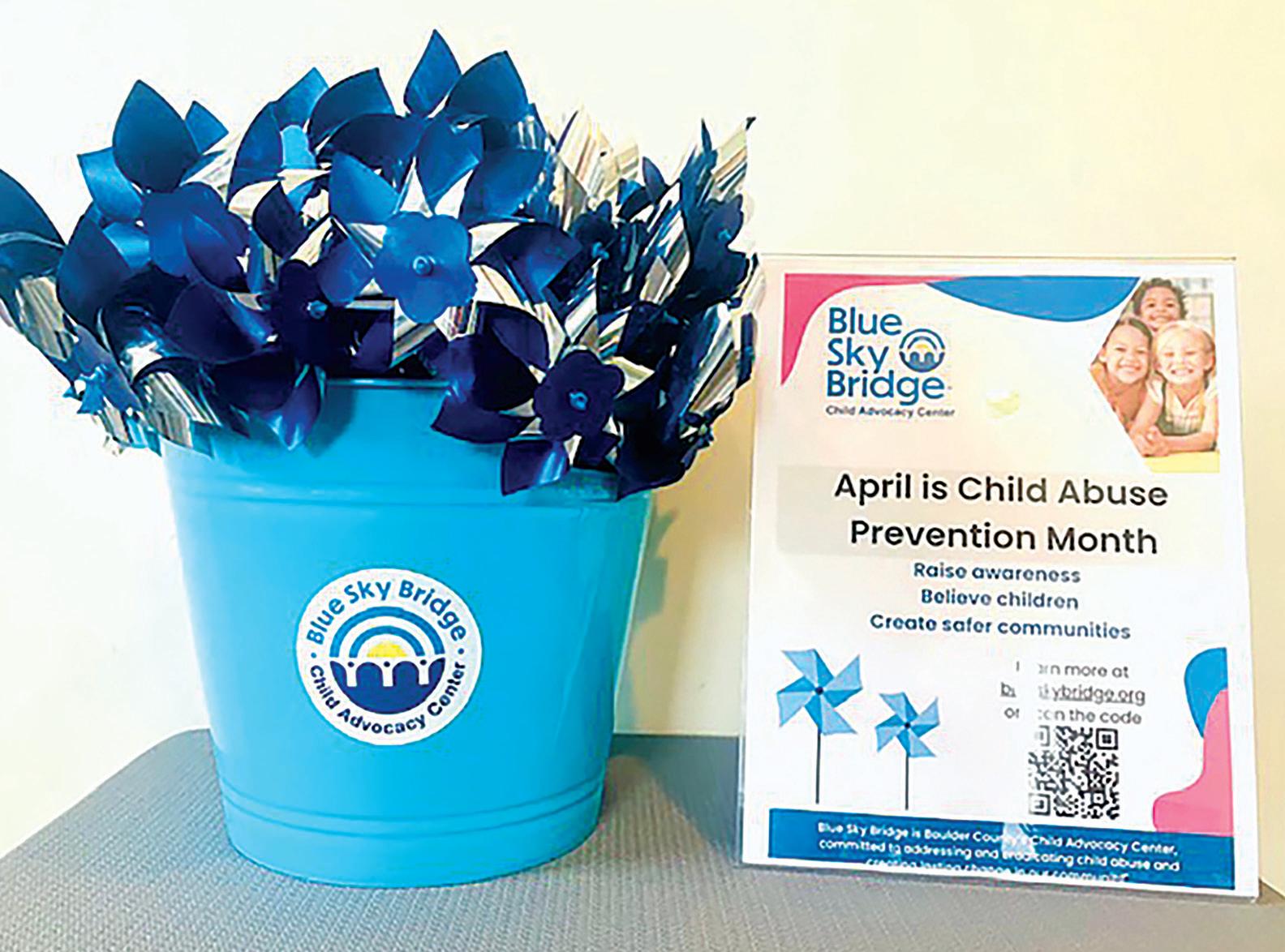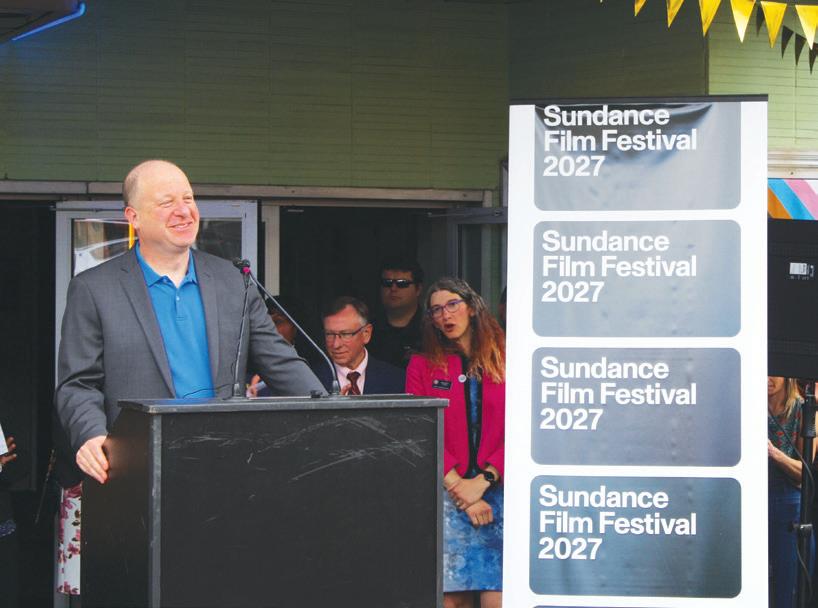

UTAH MOURNS THE LOSS



16























































































































































































































































UTAH MOURNS THE LOSS



16





















































































































































































































































The housing crisis facing individuals with intellectual developmental disabilities
BY JENN OCHS
APRIL 3, 2025
Volume 32, Number 33
PUBLISHER: Stewart Sallo
EDITORIAL
EDITOR-IN-CHIEF: Shay Castle
ARTS EDITOR: Jezy J. Gray
REPORTERS: Kaylee Harter, Tyler Hickman
FOOD EDITOR: John Lehndorff
CONTRIBUTING WRITERS: Rob Brezsny, Michael J. Casey, Angela Hart, Lauren Hill, Jenn Ochs, Dan Savage, Gabby Vermeire
COVER: Jezy J. Gray
SALES AND MARKETING
DIRECTOR OF ADVERTISING: Kellie Robinson
SENIOR ACCOUNT EXECUTIVE: Matthew Fischer
ACCOUNT EXECUTIVES: Chris Allred, Austen Lopp
SPECIAL PROJECTS MANAGER: Carter Ferryman
MRS. BOULDER WEEKLY: Mari Nevar
PRODUCTION
CREATIVE DIRECTOR: Erik Wogen
GRAPHIC DESIGNER: Chris Sawyer
CIRCULATION
CIRCULATION MANAGER: Cal Winn
CIRCULATION TEAM: Sue Butcher, Ken Rott, Chris Bauer
BUSINESS OFFICE
BOOKKEEPER: Austen Lopp
FOUNDER / CEO: Stewart Sallo
Aterm I hear quite often is IDD, or Intellectual Developmental Disability. What does that mean?
According to the International Classification of Functional Disabilities, IDD is a disorder which begins in a person’s developmental period, conception to early 20s, that includes both intellectual and adaptive functioning difficulties in any part of daily activities.
Most disabilities acquired at birth tend to be intellectual developmental disabilities; the most common diagnosis is autism. Not all disabilities are an IDD.
I sit on the board of the Association for Community Living (ACL) in Boulder. The ACL started in the ’60s when a group of parents of children with IDD united in
response to children with disabilities not being allowed to attend public school. Most people who have IDD live with their parents who act as caregivers. The fear of these parents is, “Who will take care of my child when I’m gone?”
According to the nonprofit Inclusive Housing Coalition (IHC), 73% of individuals with IDD in Colorado live with aging family caregivers.
In 1999, the U.S. Supreme Court ruling in Olmsted v. L.C. gave people with disabilities the right to choose whether to live in the community or in an institution. Judy Heumann, known as the mother of the disability movement, created the first independent living center in Berkeley, California. Independent living grew as
As Boulder County’s only independently owned newspaper, Boulder Weekly is dedicated to illuminating truth, advancing justice and protecting the First Amendment through ethical, no-holds-barred journalism and thought-provoking opinion writing. Free every Thursday since 1993, the Weekly also offers the county’s most comprehensive arts and entertainment coverage. Read the print version, or visit boulderweekly.com. Boulder Weekly does not accept unsolicited editorial submissions. If you’re interested in writing for the paper, please send queries to: editorial@ boulderweekly.com. Any materials sent to Boulder Weekly become the property of the newspaper.
1495 Canyon Boulevard, Suite CO 1, Boulder, CO 80302
Phone: 303.494.5511, FAX: 303.494.2585 editorial@boulderweekly.com www.boulderweekly.com
Boulder Weekly is published every Thursday. No portion may be reproduced in any form without written permission from the publisher. ©2025 Boulder Weekly, Inc., all rights reserved.
Boulder Weekly welcomes your correspondence via email (letters@boulderweekly.com). Preference will be given to short letters (under 300 words) that deal with recent stories or local issues, and letters may be edited for style, length and libel. Letters should include your name, address and telephone number for verification. We do not publish anonymous letters or those signed with pseudonyms. Letters become the property of Boulder Weekly and will be published on our website.
states realized it was more cost-efficient than institutions or a skilled nursing facility, with better outcomes for residents.
With the focus on independent living, many institutions and group homes have been closed. But there has not been a comparable expansion of supportive units, resulting in fewer housing options and creating a housing crisis for individuals with IDD. At least 127,000 people in Colorado have requested housing services from IHC, which formed in 2019 to bring awareness to the housing crisis for this population.

example: Safe at Home is a remote service that can alert residents if a stove is left on or a door is open.

There’s some hope as communities like The Grove are in development. This Broomfield project — the first for that city/county’s housing authority, Broomfield Housing Alliance — was designed as a neurodiverse community. It features 40 units of affordable housing and programs “specifically to support residents with intellectual and developmental disabilities,” according to the project website.
I am a resident of 30PRL, which includes 20 units of neuro-inclusive housing and an on-site provider of supportive services. (I have not utilized them; they are available to residents through a service coordinator, case manager or referring agency, according to a spokesperson for the service provider.)
Remote services offer some hope as well. Assistance can be provided through iPads and mobile devices; for
In 2023, Colorado obtained a $43 million Money Follows the Person grant to help facilitate transitions from nursing home settings to community living for people with disabilities. The IHC lobbied the Colorado Division of Housing requesting the creation of supportive housing vouchers that can blend with home and community support services specifically for the IDD community. Hopefully, the state will listen.
I hope that in the future, supportive housing will become the new normal. If housing and support services were built around the individual, the disability community could be more involved in the general community.
Jenn Ochs lives in Boulder and enjoys listening to music, podcasts and audiobooks while painting or drawing. She is a disability rights advocate, award-winning columnist and a graduate from Baylor University in Texas, which is where she realized that Boulder is the best place to live.





Kids are learning to prevent and report abuse, but funding cuts could end in-school program
BY SHAY CASTLE
Content warning: This article discusses sexual violence and childhood sexual abuse. It may be upsetting to some readers.
Susana Avelar has started to notice something during her work for Blue Sky Bridge. A forensic interviewer, it is her job to speak to children who have experienced sexual abuse and gather details of the incidents. The taped conversations are admissible as evidence, allowing kids to avoid cops and courts altogether.
The youth she interviews in Boulder County often have things in common, a similar language. They use correct anatomical language for their body parts. They are clearly communicating what happened to them, report saying no to their abusers, and quickly telling trusted adults — all facets of Blue Sky Bridge’s school-based education programs.
“One kiddo, he was quoting the program in the interview,” Avelar said. “He followed the steps he was told to do tell a trusted adult, and when they didn’t react as they should have, he told

again. This is something straight from the curriculum given to third graders.”
That example is one of many that have led Avelar to believe Blue Sky Bridge’s in-school work is having a positive impact in children’s lives.
“Kids are reporting much faster than what we’d been seeing; we’re seeing things be less egregious,” she said. While the abuse is still happening, kids are armed with the knowledge and skills to self-report, rather than authorities being alerted by hospitals or other mandatory reporters.
“We were seeing cases not coming out until there’s a pregnancy or someone got caught. That’s what we mean by less egregious — it’s only happening twice instead of years and years of abuse.”
Blue Sky Bridge intends to hire a third-party research consultant to explore whether or not these observations are accurate.
“I’m waiting to kind of get that verification that it’s not just in my head,” Avelar said. “It’s sometimes even a feeling you get; there’s something different about how Boulder kids talk about sex abuse when they’re coming in for these interviews.”
But while Blue Sky Bridge awaits proof that the programs are working, the instruction itself may be on the chopping block as the nonprofit — and others like it throughout the country — are facing a funding shortfall at the federal level.
Between them, Avelar and her fellow interviewer Jillian Reid have conducted more than 2,800 forensic interviews; 432 in Boulder County alone.
Childhood sexual abuse (CSA) is incredibly prevalent. Numbers vary, but Blue Sky Bridge says 1 in 10 children will experience CSA before they turn 18. There were 329 reported cases of child exploitation from 2019-2024, according to data from the Boulder County District Attorney’s Office.
“The sad reality is that a large amount of these types of incidents go unreported,” District Attorney Michael Dougherty said in an emailed statement, “which means that victims never receive treatment or justice.”
To try and lessen the prevalence, Blue Sky Bridge developed training for kids and adults. Their body safety curriculum, which began in 2010, was taught to students in kindergarten, third and fifth grades at 62 schools throughout Boulder Valley School District (BVSD), St. Vrain Valley School District (SVVSD) and private schools in 2023-2024.
Last year, five staff members and 25 volunteers visited 347 classrooms, reaching a total of 6,667 kids and 1,858 school staff and parents. Blue Sky Bridge has been doing school-based education since 2010; thousands of students have received body safety education over the past 15 years.
According to Avelar, the program’s

impact extends beyond the students who participated.
“Even if they didn’t attend a program, their friends were telling them, ‘You should tell,’” she said of her interview subjects. “Whereas in other counties, we were seeing kids hold secrets for kids. That’s another thing from the curriculum: We don’t keep secrets.”
As mandatory reporters, all BVSD staff must immediately notify law enforcement about suspected abuse. District spokesperson Randy Barber said “it doesn’t surprise” him that body safety lessons are having an impact.
“What Blue Sky Bridge is hearing is what we’re hearing,” Barber said. “That is something worthwhile to compliment and celebrate. Not every program has that kind of feedback.”
Despite that feedback, Blue Sky Bridge might have to scale back its schoolbased education as it faces severe funding cuts.
A significant source of revenue for the nonprofit is the federal Victims of Crime Act (VOCA) fund. Paid for by fines and penalties associated with federal court
cases, VOCA has been drying up for years due to changes in the criminal justice system resulting in fewer cases, particularly during COVID.
Colorado has lost 76% of VOCA funds since 2018, The Denver Post reported in December, leaving child advocacy centers across the state reeling. Experts anticipate another 27% drop in 2025.
“It’s been coming down for a while,” Avelar said. “This year is when we feel the hit.”
Blue Sky Bridge has so far been able to patch the gaps with other funding, but their ability to fill the hole is declining.
“The overall cost of operations continues to rise,” said Heidi Lawrence, Blue Sky’s development manager. “We look for support from other grants, individual donors, business sponsorship and family foundations to ensure our ability to bridge this gap and meet the needs of children and families in our community.”
Serving as a child advocacy center the place where kids who are victims of and/or witnesses to certain crimes of abuse go — is Blue Sky Bridge’s primary mission. If more money can’t be found, “the first program that’s going to
be dropped is prevention,” Avelar said. “If the call is between prevention and responding to things that have already happened,” she said, “unfortunately we’re going to have to go with things that have already happened.”
To go to schools and train students, teachers and staff, it costs Blue Sky Bridge $86.77 per child and $31.33 per adult. Grants and donations pay for a majority of the in-school programs, according to Lawrence.
BVSD paid Blue Sky Bridge $25,000 for body safety education last school year, Barber said. He wouldn’t speculate on what the district might do if Blue Sky had to cut its prevention programs.
The district is facing its own uncertain financial future under the state’s constrained budget.
“It’s way too premature to know what those impacts might be,” Barber said. “We’re all looking at this funding challenge and saying, ‘How do we keep a really good thing going for the students?’
“That unfortunately is the time we are in right now.”
Attend one of Blue Sky Bridge’s trainings
BODY SAFETY IN THE ONLINE WORLD
THURSDAY, APRIL 10 6 –7:30 p.m.
Southern Hills Middle School, 1500 Knox Drive, Boulder Register: bit.ly/ OnlineBodySafetyBW
Adults will learn practical actions they can take to reduce instances of child sexual abuse in their organizations, families and communities.
FRIDAY, APRIL 11
9:30 –11 a.m.
Blue Sky Bridge, 2617 Iris Hollow Place, Boulder Register: bit.ly/ StewardsofChildrenBW
Learn about development at each age (normal to problematic) and how to have open conversations with children about bodies and behaviors
WEDNESDAY, APRIL 10 6 –7 PM
Virtual presentation via Zoom Register: bit.ly/ OpenConversationsBW
COFFEE AND CONVERSATION ABOUT BODY SAFETY
TUESDAY, APRIL 22
9:30 –10:30 a.m.
Boulder JCC, 6007 Oreg Ave. Register: bit.ly/BodySafetyJCC
BY TYLER HICKMAN
The Colorado Energy and Carbon Management Commission (ECMC) approved the Draco Pad, a 26-well fracking site that will extend for five miles beneath Erie, with a 4-1 vote during its March 26 hearing.
The decision on the proposal site, which is located in Weld County just outside Erie’s city limits but would extend underground into Boulder County, was postponed in November last year after ECMC commissioners asked Civitas Resources to explore alternative locations because of these jurisdictional issues.
After exploring an alternative location within Erie, Civitas found that it was not viable, and the commission approved the original site plan.
“While the Town of Erie is disappointed with the Commission’s decision, the Town is committed to protecting the health, safety and welfare of its residents,” the town said in a March 26 release, “and will continue to do so irrespective of this ruling.”
The Draco site, which has received significant pushback from Erie residents, sits near a 1,400-home planned development that would place 72 homes within the 2,000-foot state mandated setback.
At the request of the town, pre-production at the site — which includes drilling the wells — will be completed no later than May 13, 2028, with a reasonable attempt to finish by October 2027, to limit the impacts to nearby residents.
According to the press release, lots within 2,000 feet of the site won’t be occupied until May 2027.
Civitas also agreed to plug and abandon 22 wells along with 18 oil and gas facilities, many of which are located in western Erie.
The Boulder County leadership of the local NAACP chapter announced it will dissolve in a March 28 email. The par-
ent organization is pushing back.
A separate release from the national NAACP on April 1 refutes any claim of dissolution as “completely false,” stating “members cannot close NAACP Chapters. Per the NAACP Constitution, only the Board of Directors has that authority, and it has not voted to do so.”
In an April 2 phone call with Boulder Weekly, the group’s former vice president Judith Landsman says this isn’t true. The chapter “dissolved itself as an entity and filed for legal dissolution with the State of Colorado by unanimous decision of the former NAACP Boulder County executive committee.”
Landsman said no effort has been made by the State of Colorado to halt the dissolution. “As far as we know, it’s done. And if NAACP national wants to push it, then they’ll have to challenge it legally,” she said.
The local chapter cites the ongoing struggle with the City of Boulder, stemming from the organization’s opposition to the appointment of Stephen Redfearn as Boulder Chief of Police, due in part to his involvement the night of 23-year-old Elijah McClain’s killing.
“We faced a relentless campaign from the city manager and police chief to discredit and undermine and ultimately destroy our branch,” the Boulder County NAACP said in its release, “because of our refusal to support the promotion of Stephen Redfearn to police chief or remain silent.”
The release also states the national NAACP succumbed to “the threat of legal action from the city,” issuing cease-anddesist letters regarding statements the local chapter had made against Redfearn.
In its own statement released March 29, the City of Boulder refutes any threat of legal action against the chapter, saying the statement is “simply untrue.”
In October 2024, the city did file a complaint with the national NAACP against three members — president Annett James, vice president Landsman and criminal justice committee chair Darren O’Connor — regarding an incident where the group “threatened” to release a transcript of a meeting with Boulder City Manager Nuria Rivera-Vandermyde and Redfearn, which a member of the chapter recorded in secret.
According to the release, the Boulder County NAACP executive board voted
unanimously to dissolve after the national NAACP expressed interest in taking over the branch.
“There was a very aggressive response to basically turn the administration of the branch over to someone from the national board as an overseer,” Landsman told Boulder Weekly. “It became clear that part of that administratorship was going to be to remove elected leadership.
“We were backed into a corner. We could either succumb to being another mouthpiece for the city, or we could keep our integrity.”
In an April 2 Instagram post, city council member Taishya Adams expressed her discontent with the situation. “As a member of the NAACP Boulder County branch, I believe the entire membership should have been included in such a foundational decision to close our chapter,” Adams wrote. “I look forward [to] more clarification about the road ahead and continue to be open for the much needed repair within and across our Black identifying community and allies.”
Landsman is uncertain what comes next in the wake of the dissolution. “There is a void, and we can’t say who’s going to step up and when it’s going to happen,” she said.
After an off-season filled with speculation on whether Deion Sanders would sign an extension to stay on as CU football’s head coach, or jump ship for a bigger contract, Buffs fans have an answer: Coach Prime is staying in Boulder.
CU inked a $54 million extension for Sanders through 2029, with a guarantee of $10 million per year — nearly double his previous contract.
Coach Prime, who inherited a 1-11 team in 2022 and
led them to a 9-4 season and a bowl game just two years later, has brought more than just wins to the program.
In 2023, home football games brought $93.9 million in direct economic impact to Boulder, and $146.5 million in total regional impact according to a university press release. Since Sanders’ first season, applications to CU shot up by 20%, with significant increases in applicants’ diversity: prospective students who identify as Black and non-white increased by 50.5% and 29.3% respectively.
“Coach Prime has done a masterful job transforming CU Boulder’s football program into the must-watch matchup nationwide, week after week,” CU Chancellor Justin Schwartz said in the release, “and I’m excited to see what the team will accomplish under his leadership in the next five years.”
• The Hotel Boulderado has new owners — and big plans. Longtime owners Frank and Gina Day sold a majority share of the historic Boulder landmark to Nashville-based real estate company AJ Capital Partners. The company plans to redesign guest rooms and public spaces, but is “committed to preserving Hotel Boulderado’s architectural splendor and role as a cherished amenity,” according to a March 31 press release.
Renovations are set to begin later this year and be completed by spring 2026, at which point the hotel will join the Graduate by Hilton collection, which owns more than 30 hotels in university towns across the U.S. and U.K.

What your local officials are up to this week
BY BOULDER WEEKLY STAFF
At the April 10 study session, council will:
• Hear findings from a study on how “replacement homes and substantial additions to homes contribute to the need for affordable housing” and discuss putting an impact fee on these types of developments.
According to a city memo, singlefamily redevelopment often replaces “smaller, relatively affordable” homes with “large expensive” homes, and substantial additions reduce affordability as well.
Single-family home teardowns aren’t subject to the city’s inclusionary housing regulations — which requires new developments to pay into the city’s affordable housing fund — because they aren’t considered new development.
The impact fee would be paid into the city’s affordable housing fund. If council agrees with staff’s recommendation to move forward with an impact fee, staff will meet with stakeholders and begin engagement in April. The new code would be developed later this summer/fall.
At the March 27 meeting, commissioners:
• Approved some budget requests, but denied others as part of a quarterly budget amendment process.
Commissioners approved, for example, two new employees in the county attorney’s office to “address additional workload” resulting from the newly formed union. They denied the sheriff’s office’s request for $2,319,823 to add 25 fulltime equivalent employees for the new booking and housing wing of the jail as well as $303,572 for new vehicles.
There were 50 budget requests totaling $12,043,197. Commissioners formally approved $8,521,427 at the April 1 meeting.
On Monday, April 7, commissioners will:
• Hear a presentation from Front Range Nesting Bald Eagle Studies President, Dana Bove, on Stearns Lake in Carolyn Holmberg Preserve. A pair of eagles has nested in the area for over a decade and has recently been disturbed by “a dramatic increase in trail use that has forced them from their long-held territory,” Bove wrote in a March 2 opinion piece in the Daily Camera
The virtual meeting is open to the public, but no public comment will be taken. Registration required: bit.ly/ StearnsEaglesBW

On Tuesday, April 8, commissioners will:
• Decide whether to approve a transfer of 14 properties that were acquired by the county after the 2013 flood. The private residential properties had been severely damaged in the flood and were put into open space uses. Parks and Open Space has suggested transferring them “to applicants who competed in a detailed public process to find private individuals and entities that will be best suited to own and manage them, and to retain ownership of one.”
The properties would continue as open space and remain undeveloped, according to the agenda.
At its April 1 study session, council:
• Reviewed options for an ordinance that would restrict where registered sex offenders can live. The push for this legislation has come in response to a group
of residents who first expressed concerns at a Feb. 25 meeting regarding a sober living facility in their neighborhood that was housing six registered sex offenders.
After an overview of multiple setback distances, council directed staff to draft an ordinance that will restrict all registered sex offenders from living within 1,000 feet of schools and daycares, and 500 feet from public and private parks.
At the April 1 meeting, council:
• Heard a presentation of polling questions for the community on whether the city should place a question on the November ballot asking for funding for three potential capital projects: an expansion of the aquatic complex at the Bob L. Burger Recreation Center, a renovation of the Parks and Public Works Service Center and a new Civic Center to replace the current City Hall. The city is hosting community info sessions at City Hall, 1290 S. Public Road, 6-7 p.m. Wednesday, April 30 on fiscal responsibility and Thursday, May 15 on environmental stewardship and sustainability.
• Set a public hearing and vote to determine eligiblity for annexation of 78 acres of undeveloped property northwest and southwest of the Intersection of Baseline Road and N. 119th Street currently in unincorporated Boulder County. The owners have proposed a mixed-use development on the property called Gateway Lafayette.
Went into executive session:
• For legal advice on the city’s home-rule authority. At a March 4 meeting, council previously agreed to meet in executive session to discuss the effects of state legislation on local planning and zoning regulations, specifically HB 24-1313, Housing in Transit-Oriented Communities, which requires cities of a certain size to allow more dense housing in areas served by buses, light rail or other transit. In Lafayette, it could result in 7,000 to 30,000 more homes, according to previous Boulder Weekly reporting.
All agenda items are subject to change. Karen Norback contributed reporting.


Your burning questions on romaine and romance, asked and answered
BY GABBY VERMEIRE
The next two days are scientifically the longest two days of the year, and don’t simply take my word for it.
Just ask a NIST scientist … oh wait, DOGE does not allow them to respond to external inquiries at this time. What I’m trying to say is that the first Boulder Farmers Market of the year is in two days omgomg. I hope your Free People maxi skirt is thrifted and your crop top is itty-bitty, because that ’fit better leave no crumbs when you’re competing with a Black Cat Farm employee who looks like a literal American Apparel model.


some market you-know-what, and I must say: This is a family-friendly market, have you no shame?? Get your head out of the gutter, the Jeff and Paige show is about to start! If only they weren’t literally singing about the birds and the bees. Uh … look, how wholesome! There are some new age dads dancing with their kiddos to Trevor Hall songs in the grass. Is it just me or are they all really … hot??
In the meantime, this advice column is here to hold space for you and your Boulder Farmers Market queries (especially the uncool ones).
How TF do I get a BF at the farmer’s market?
So many reader

Be it the bouquets of yonic lilies, the sensual, voluptuous ridges of the most curvaceous heirloom tomatoes, or the downright sexual Palisade peaches, you’re justifiably horned up! There’s nothing when you’re feeling thirsty like the Eldorado Water booth, where the sicko working there forces your parched ass to sip from cups made for ANTS.
(Sidenote: You know who else thinks those tiny cups are fucked up? Earth Man, probably. Yeah, he’s there too.)
What I’m trying to say is that you should guard the Eldorado Water from hot dudes and only let them use it if they’ll go on a date with you.
When are the veggies a rip off?
I know the feeling — you felt like a proper Brigid, goddess of the harvest, when you stocked TF up at the market, but then the eternal craving for Whole Foods bythe-slice pizza struck and you needed to
make an Ideal Market run, squirreling away your market produce deep in your tote. You shouldn’t have looked, but now the $0.99/lb new potatoes mock your foolishly bougie ways. Being ripped off, however, is a state of mind: Think of the extra cost as a tax for the sense of superiority you gained by supporting local farmers. Plus, the Whole Foods cashiers never throw in an extra garlic bunch for the seethrough maxi skirt and black panties.
How do you respectfully shoot your shot with the hot farmer selling you organic kale?
It’s generally unethical to shoot your shot with anyone serving you while they’re on the clock, where the pressures of customer service could create the unpleasant choice of accepting a date with someone they’re not into or risk offending you, the customer, who is legendarily always right. Oh wait, this is supposed to be a funny advice column. Uhh … buy the kale and
then come back to the stand with nothing on but two lacinato fragments covering your nipples (How are they staying on? Highland Honey samples, duh) and seductively purr, “Hey baby, guess what else you should probably wash before eating but definitely won’t?”
Tips for creating a farmer’s market supper of your dreams
1. Become a creature of the (Wednesday) night (market) If the Saturday morning market feels too “Oh my god I am way too high to be this overstimulated right now,” the Wednesday night one is its more intimate, Indica-coded sister. Shopping for dinner on an empty stomach is also an enticingly Euro exercise in bad decision-making.
2. Sample the unsampleable Everyone knows buying the first carrots of the season is some messed up Russian roulette: You’re either biting into a sweet crispy-boi or gagging on an overwintered, totally mid tuber that feels like chomping down on a climbing shoe. No samples? Demand one; you’re worth it.
3. Text your dinner date “Cooking bad. Bby girl hungry. Papusa gooood.”
Got a burning Boulder question? DM @ wholefoods_daddy on Instagram or email letters@boulderweekly.com with the subject line “Dear Whole Foods Daddy.”

BY LAUREN HILL
As the future grows more uncertain, indie singer-songwriter Alice Phoebe Lou is eager to look back.
This much is clear from her two most recent singles released last year. “Better” and “The World Above” are reflections on an angstier, younger self, full of 20-something longing. In these moments of retrospection, it’s easy to find a bit of cringe and regret — but in a show of maturity, she opted to be gentle with her past self instead.
“To go back and to re-encounter those feelings is like a conversation with yourself — it’s a good perspective to put yourself in because you can see how far you’ve come, like you’ve come out on the other side in some way,” Lou, 31, says. “I love that shit. It helps me understand who I am now.”
These moments of creative reflection spurred a desire for something deeper and more intense: an entirely self-produced album, to be released independently later this year, composed of songs half-written over the past decade and completed, compiled and performed entirely solo. Lou says the as-yet untitled new album, whose debut single “You And I” drops April 11, will channel an imperfect acoustic sound akin to the likes of Nick Drake and Joni Mitchell’s more scaled-back works.
for me as well,” she adds. “Just allowing for that janky, wonky, imperfect thing. It really is a lesson in not taking yourself too seriously, not feeling like everything needs to be clean and tied with a bow.”
This attraction to messiness might surprise those familiar with Lou’s career since launching herself onto the scene with her debut LP Orbit nearly a decade ago. Following the success of songs like the 2020 single “Witches” and “Open My Door” from the album Shelter a few years later, she’s since become your favorite indie darling’s favorite indie darling.
After spending the tail end of last year supporting Clairo’s Charm Tour, Lou will play a handful of shows with Remi Wolf, including her Red Rocks show on April 10, and will open a stretch of dates with Denver-born band Tennis later this year.

challenges that constantly threaten any built-up sense of security.

“America used to be this huge battle, this overwhelming, massive place where you don’t even know where to start putting yourself out there,” Lou says. “I would tour there and come back with negative money and backache from people’s couches. It always felt a bit like, ‘Is this gonna be worth it?’”
Now, Lou is enjoying the kind of hardearned success that comes from putting yourself out there, over and over and over again.
“Playing Red Rocks — there’s no way that was even a potential on my horizon,” Lou says. “America’s been giving me a lot of love. It’s a bit of a scary place right now, but I love the people, I love the fans and the energy. It’s a whole ‘nother level out there.”
Despite breakthroughs into the mainstream indie-pop zeitgeist, the goal was always that simple. To this end, Lou plays free shows multiple times a year, usually in her home city of Berlin. She performs outside U-Bahn stops and in her favorite park, telling fans the day before to meet her “just outside the station, under the big tree.”
These spaces provide an opportunity for her to experience music in its purest form: She gathers her gear, lugs it down the subway steps, and fosters a moment of magic in a spontaneous, intimate setting.
“It’s a beautiful exercise in my own pursuit of what I like, and what I want, as well as a really nice retrospective moment,” Lou says. “It’s like when you’re moving houses; you go through all your old shit and you’re supposed to be packing, but you end up down a rabbit hole, reading some old letters from a lover.”
“Some of them will feel unfinished to the listener, but that was kind of the point
“[The Charm Tour] definitely felt like a turning point,” Lou says. “It has felt like I’ve been kind of welcomed into the proper American indie ranks.”
Even after securing a sure spot in these so-called indie ranks, it’s easy to feel like the early hustle is never all that far in the past. Originally from South Africa, Lou moved to Europe in her late teen years and eventually settled in Berlin to pursue music.
Global tours may feel like a career milestone, but they come with a host of
Opportunities to open for artists with a broader and sometimes younger fanbase have also been a special experience, according to Lou. In an industry dominated by short-form compatibility and minimal attention spans, it can be difficult to break out beyond a core group of supporters.
“I really want to connect with younger people, but I am, like, allergic to the TikTok thing,” Lou says. “I just want to play music, and to be able to play in front of people.”
“It’s an exchange of energy and music at its core. It’s creating a tiny little bubble that anyone can step inside and feel connected and warm,” Lou says. “I’ve always loved watching somebody’s face just light up — somebody who wouldn’t usually be going to a concert, who maybe doesn’t have those things in their lives, encounters this spontaneous act of art and activity. I think there’s nothing like that feeling.”
ON THE BILL: Remi Wolf with Alice Phoebe Lou and Dana and Alden. 6:30 p.m., Thursday, April 10, Red Rocks Amphitheatre, 18300 W. Alameda Pkwy., Morrison. $75



BY BOULDER WEEKLY STAFF
In like a lion, out like a lamb. It’s the season of change, and you can tell from our listening habits. February found us bumping Kendrick on a sugar rush from his iconic Super Bowl halftime show, but now we’re feeling more wistful with the tender Americana of Jason Isbell and the return of indie-pop darling Japanese Breakfast. Whether this shift finds you going through it, or just looking for something fresh, here are the bestselling new vinyl releases at Paradise Found Records and Music
1. NOAH KAHAN
from Fenway Park
2. JASON ISBELL Foxes in the Snow
3. JAPANESE BREAKFAST For Melancholy Brunettes (& sad women)
4. CHARLEY CROCKETT Lonesome Drifter
5. LADY GAGA Mayhem
You don’t need to understand Japanese to be moved by the ambient folk sorcery of singer-songwriter Ichiko Aoba. Her latest album Luminescent Creatures proves as much, transcending language with its aching acoustic arrangements and crystalline vocal performance. Out now via Psychic Hotline, the shimmering work clocked in at No. 7 on last month’s Found Sound Top 10. Keep an eye out for an interview with Aoba ahead of her performance at Denver’s Paramount Theatre on May 1.
— Jezy J. Gray, arts and culture editor



BY MICHAEL J. CASEY
The Sundance Film Festival is coming to Boulder — that you’ve probably heard. You’ve also probably heard a dozen reasons why it’s leaving Utah and a dozen more why it picked Colorado. It’s an exciting time to be a moviegoer along the Front Range. But back in the Beehive State, the buzz is slightly different.
“During the festival itself, obviously, this was a big topic,” Salt Lake City Weekly’s Scott Renshaw says of the 2025 Sundance Film Festival. “As I was talking with people there, I said: ‘Yeah, I would lean 55 percent to it staying.’ Then, the legislative session completed, and we were all like: ‘This is bad.’”
Renshaw, arts editor and film critic for the long-running, free alternative weekly newspaper, has covered Sundance for more than 25 years. Like many others, he had a decent amount of skepticism over one of the country’s most storied film festivals leaving its home state of 40-plus years. But then came Utah House Bill 77 (which would ban the flying of pride flags on government property), and the likelihood of Sundance staying in Utah “was diminishing by the day.”
“It felt like...” he says, gathering his thoughts. “Like, the patient is terminal, and we’re just getting a chance to say our goodbyes.”
Utah’s HB77 became law without Gov. Spencer Cox’s signature at 9:57 a.m. on March 27. Less than two hours later, Sundance announced it was moving to Boulder.
That’s quite a coincidence, but it’s worth pointing out that the Sundance Institute, which hosts the January festival, has done a magnificent job navigating politics throughout the departure.

Among the possible cities Sundance considered was Atlanta, which garnered its own headlines in 2021 when Major League Baseball retracted their annual All-Star Game from Braves stadium Truist Park after Georgia passed the Election Integrity Act.
And where did MLB relocate the ’21 All-Star Game? To Coors Field in Denver, naturally.
Though Renshaw has covered the festival, he is quick to point out that he isn’t a Sundance insider and hasn’t had a chance to speak to anyone within the organization. “I don’t think they would,” he says. “Even if I asked them directly: ‘Is the reason they’re going to Colorado because it is a bluer state?’ I don’t think anyone would actually say that out loud. But I think it’s delusional not to think that’s at least a part of it.”
Renshaw is quick to point out that even though politics played a factor, they weren’t necessarily “the factor.” That one might have come down to sheer logistics.
“[Sundance] had outgrown Park City 15 years ago,” Renshaw says. “It’s been clear that the infrastructure of Park City had never been designed for something like this.”
According to Sundance, the 2024 festival attracted 72,000 attendees, with about

33% coming from out of state. For those 24,000 travelers, the cost of lodging was probably their biggest concern.
“It was just becoming prohibitively expensive for guests to come there,” Renshaw says, adding that the housing issue isn’t “unique to Park City.”
Nor is it to Boulder. But lodging is certainly more difficult to overcome in a mountain ski town void of high-rise hotels or “places to put people at more reasonable rates.”
“Obviously, nothing is going to be cheap, nothing’s going to be inexpensive,” Renshaw says. But, by moving Sundance to Boulder, out-of-towners’ only options aren’t going to be “someone’s ski chalet that they’re going to rent out to you for $7,000 a night.”
That, even more than politics, might be the topic du jour when the Boulder Sundance debuts in 2027.
“I’ve never been to Boulder,” Renshaw says. “But I’ve been to Park City, I’ve worked in Park City, I’ve lived here in Utah for nearly 30 years — I think anything has to be a little bit better. From a just pure logistic standpoint.”



$10 off all current hiking styles, 25% off all discontinued hiking styles




BY MICHAEL J. CASEY


It started in 1975 when a friend of film critic Roger Ebert suggested watching a movie, one frame at a time. The esteemed Chicago SunTimes arts journalist had been attending the Conference on World Affairs, held every spring at CU Boulder, as a guest since 1970 and thought the idea was a good one.
Follow the yellow brick road to The Wizard of Oz at Ebert Interruptus.
Courtesy: MetroGoldywn-Mayer
So they borrowed a stop-action projector, the kind football coaches used to break down game footage, and invited conference attendees to dissect Citizen Kane, one frame at a time, inside the Fox Theater. A tradition was born.
The series went by many names (How to Read a Movie, Decoding a Movie, Analyzing a Film, etc.) before settling on Cinema Interruptus in 1996. An ideal choice for a series encouraging the audience to talk during a movie with observations and questions. CWA founder Howard Higman called it “democracy in the dark.”
THERE’S NO PLACE LIKE OZ. Star of the stage and screen, Cynthia Erivo — who played Elphaba in 2024’s Wicked — delivers CWA’s sold-out keynote address April 7.

world, it never will. For filmmaker Karyn Kusama, Oz — particularly the shot of Dorothy and Toto leaving their sepia-brown Kansas farmhouse and walking on to the Technicolor dreamscape of Munchkinland — is the moment where kids see what magic cinema is capable of. After the Ayatollah of Iran issued a fatwa for the death of Salman Rushdie, the author found resonance in Dorothy’s admission, “There’s no place like home.” And according to late filmmaker David Lynch, not a day went by when he didn’t think of The Wizard of Oz. The influences this 85-year-old work of cinema holds are but the tip of the spear. Oh, the fun we’ll have at this year’s Interruptus. Sessions will be held 5 p.m. April 8-10 in the Bruce Curtis Building on CU Boulder. Larsen will be running the show and yours truly will be manning the Blu-ray player.
In 2013, the program was renamed Ebert Interruptus following the critic’s death that April. And for the 50th anniversary of Interruptus, Chicago-based critic, author and Filmspotting co-host Josh Larsen returns to discuss and dissect a cornerstone of any moviegoer’s cinematic upbringing: 1939’s The Wizard of Oz
The Wizard of Oz is one of those movies that never went out of fashion. And as long as there are children in the
ON SCREEN: Ebert
Interruptus presents The Wizard of Oz at the Conference on World Affairs. Bruce Curtis Building, CU Boulder, April 8-10, 5 p.m. Free | Uninterrupted screening: 2 p.m. Monday, April 7, UMC East Ballroom.
steps into its Sundance era
BY JEZY J. GRAY
“The Sundance Film Festival is here to be a statewide partner, collaborating on arts and culture, education and community. We are incredibly excited to get to work with all of you.”
Gov. Jared Polis emphasized the statewide impact during his remarks, projecting a $2 billion economic benefit over 10 years with major ripple effects on the Front Range and beyond.

is a
Cloud cover offered a respite from the Colorado sun on the first balmy day of spring as hundreds gathered outside Boulder Theater for a March 27 press conference announcing the city’s successful bid to host the Sundance Film Festival beginning in 2027.
“We began this process with an open mind, driven only by our mission of serving artists, the independent film community and engaging audiences,” Sundance Institute board chair Ebs Burnough said while acknowledging the other finalist cities of Cincinnati, Ohio, and the festival’s longtime home of Salt Lake City and Park City, Utah. “But there was something about Boulder.”
While the prestigious film festival founded in 1985 by former Boulder resident Robert Redford will be anchored in the People’s Republic — which purportedly won the competitive bidding war in part due to its accessibility, walkability and proximity to nature — Burnough said Sundance hopes to enliven the arts community throughout Colorado.
“We are not here to only show up 10 days a year in one location,” he said.
“The arts are something we all enjoy as consumers … but they also put food on the table for so many people: the filmmakers, the producers, but also all those involved with the productions,” said Gov. Polis, whose mother Susan Polis Schutz is a documentarian. “There are many other Boulderites and Coloradans who work in and around creative industries as well as the tourism industry, which the Sundance Institute and Sundance Film Festival will benefit.”
Boulder wooed the country’s largest independent film festival, drawing tens of thousands of out-of-state visitors each year, with the promise of up to $34 million in refundable tax credits over the course of a decade. The bipartisan bill was passed by the Colorado Senate on March 28.
There has been speculation regarding the political valence of Sundance’s decision to relocate from conservative Utah, which on March 27 — the same day as the relocation announcement — became the first state in the nation to ban the display of LGBTQ+ pride flags on public property. Gov. Polis, the first openly gay man elected governor in the United States, downplayed this aspect of the festival’s decision-making process.
“This is not about politics. There’s Republicans, Democrats and Independents in our state who are all proud to be Coloradans. We’re proud to be part of helping people tell their stories, and we’re proud of economic development,” he said. “We put together a compelling proposal that really shows how Colorado can help be the next great chapter for the Sundance Film Institute, and I think that’s what won the day.”





‘White Lotus’ costume designer talks ‘loud luxury’ ahead of Denver runway show
BY JEZY J. GRAY
The word vacation arrives in English via the Latin vacare: “to be empty.” You could say the same for the vacuous travelers of The White Lotus, HBO’s steamy hit drama series chronicling the upper-crust exploits of wealthy resortgoers in farflung locales.
There may be an emptiness to the interior lives of the rich pricks and demanding divas checking in and out of the show’s titular hotel — placed so far in Hawaii, Italy and Thailand — but on the outside, it’s a different story.
Enter costume designer Alex Bovaird. Since the show’s first splash in Maui, the Emmynominated fashionista has been the driving force behind the signature White Lotus look: flowy tropical prints, designer linens and high-end resortwear signaling the wealth and privilege of its intertwining characters as they stumble into a spiderweb of sexscapades, class politics and murder.
With a resumé boasting big-budget films and TV staples like Nope and True Detective, Bovaird’s eye for character-driven looks has helped define some of the decade’s most enduring pieces of pop culture. That’s why she’ll be honored with an award ceremony during a Fashion in Focus event at this year’s SeriesFest, the Front Range’s annual star-studded slate of premieres, panels and parties celebrating excellence in television.
Bovaird, 47, on a video call to talk about the craft of costume design and her favorite fits from the latest season.
The following has been edited for length and clarity.
Hi Alex. Thanks for chatting with me. Where am I catching you?
I’m doing overnights for a feature called Primetime being filmed in New Orleans. It’s almost finished, but we’ve got three weeks of nights right at the end, so they’re just kind of killing us right when we’re about to give up anyway [laughs].
Sounds grueling.
It is. People think my job’s really glamorous, and it’s not actually. That’s why I like talking to journalists, because this is the glamorous part of it, where everyone’s like: “Wow, tell us some stories!”


What does your work look like on a day-to-day basis?
Ahead of the April 3 event at the Ellie Caulkins Opera House in Denver — complete with a White Lotus-inspired runway show — Boulder Weekly caught up with the U.K.-born, Nashville-based
When you’re the costume designer, you’re responsible for every look in the show — every extra, every person with one line, and all the main characters. When I do overnights, it’s because the costume designer has to be there if a new look is on camera.
I start by doing a big prep period where I break down the script and gather everything, and I make a database of
what I need. Then we quickly start accumulating it and wait for the casting to come in, so we can match our ideas with who they’ve cast for that character. There’s X number of weeks where we’re just setting up a big warehouse, and then closer to the shoot, I have meetings with the director, the producers, the cinematographer and the production designer, and try to marry the aesthetics. As we get closer, we start doing the fittings.
On a show like The White Lotus, the
fittings are very last-minute because they don’t bring everyone to Thailand until right before they work. It all feels very slapdash, and you don’t want it to look like that. So you just prepare, prepare, prepare. You want to nail it in the fittings. You only have a few hours. You want to be ready for anything.
What about when you’re on set?
Once it starts shooting, I do a bit of everything. We’re still fitting people as they’re coming through, still preparing for big scenes and set pieces. I have to be right by camera when there’s something new going on for the first time, in case somebody is like, “Actually, we don’t want this anymore,” or something’s off lighting-wise. Then I have to go and run to the truck and get something else.
Congratulations on your upcoming awards ceremony at SeriesFest, by the way. Thank you. I can’t wait to come to Denver. I thought it was gonna go down differently. I thought maybe I’d have a break and spend a week in Colorado with my husband. But as it turns out, I’m going to be working, so I’m going to jet in and jet out. But I’m still delighted to come.
You’ll have to come back! It looks like a relaxing place.
It’s pretty chill. Not the most fashionable place in the world, though. We have to be ready to go hiking at a moment’s notice.
Wait. Are you wearing The Jesus Lizard t-shirt [from Nope]?
I was wondering if you were going to say anything.
That’s so funny. I’m wearing a Nope sweatshirt! This is almost like my house hoodie. It’s like my dressing gown. Daniel [Kaluuya] wears this at the end of the movie, and we had a lot of them because there was a lot of stunts. Daniel wears this, and Keke [Palmer] wears The Jesus Lizard. I love that t-shirt.
Can you tell me more about the look of The White Lotus, specifically in Season 3?
I’ve sort of coined the phrase “loud luxury,” in contrast to the quiet luxury trend. We always do loud, bold, adventurous. People dress up a little bit for their vacation. In The White Lotus, we harken back a little bit to the ’60s and ’70s, when people dressed up for the plane. It’s a romantic vision of who we want to be on holiday: Dress up for dinner, dress up for the pool, take risks.
Did the locale itself present challenges?
It’s extremely hot in Thailand, so we had to keep that in mind. There’s a lot of flowy dresses and flowy caftans — linen shirts for the men and flowy linen pants. That was big for us, because the heat will destroy you. Working for 12 hours outside was definitely a challenge, and we had to use fabrics and fits to accommodate that.
Some of my favorite looks this season are on Walton Goggins. Oh yeah, mine too. He looks so great.
What was the inspiration for dressing that character, and where did you source those sick Hawaiian shirts?
When you first meet [Rick and Chelsea] you’re like, “Who are these two?” It’s almost like they’re from another show.
They don’t really look like wealthy hotel guests. They look a bit more ragamuffin, like they have been on their travels for a while. The idea with Rick was that he hasn’t been in America for ages, so he’s been shopping like a traveler. He’s had his shirts for years.
There’s a huge bazaar in Bangkok and other big cities in Asia. One has, like, nine floors full of American vintage clothing [laughs]. A lot of it’s very cool: denim and band t-shirts, weird stuff that wasn’t really appropriate for anybody but Rick. His big, floaty linen trousers are from one of these bazaars. Some of his shirts
Aimee [Lou Wood], who plays his partner, was also really great. Of all the White Lotus characters so far, I saw myself the most in her: She’s British, which I am, and she’s also free spirited — sort of gentle, but also up for adventure. I felt like I knew who that woman was. I did a lot of traveling when I was younger. I went to Thailand when I was 19. I went to the Full Moon Party. She’s sort of a Bohemian dreamer meets British raver; someone who has their own idea. We cut off a lot of her dresses, so it was a lot of DIY fashion with her. I also think the trio of women [Leslie

came from there. For one of them, I copied a ’50s Hawaiian shirt and found some vintage rayon that was like 80 years old, and made a shirt. And then some are from rental houses. They’re pretty much all vintage. I think one of them is new.
Who were some of your favorite characters to dress this season? Well, Walton is super great, just to finish off with him. He’s such a good clothes horse because he’s like a model, you know? He’s tall and skinny. He won’t mind me saying that he sweat profusely, because it was so hot, which adds to the drapiness of his shirts — they just melt to him. He was really satisfying.
Bibb, Carrie Coon and Michelle Monaghan] are so good. I’m partial to them, just because there’s more you can do. On Season 2, we had “the gays,” who were a lot of fun; you could make them more flamboyant and eclectic. Other than Rick, the men of Season 3 are pretty straight down the line, and costume design is about nailing the type. There’s just a tiny bit of stereotyping that we do [laughs]. With the women, it’s a little more, “This mode. That mode.” There are different flavors.
I love when the ladies go into club mode [on Episode 5].
Oh, thank you. I love the clubbing scenes, too. There’s hundreds of extras that really have extraordinary outfits too,
but you never really see them all that much. I know the cast really appreciate it, because it helps them get into the vibe.
Have you always had the fashion bug?
Not really. I was more into music, movies and pop culture. I was always into scenes, diving into different worlds. I fell into this by mistake, randomly, around age 30. I was in New York, and someone asked me if I knew somebody who wanted to intern with a costume designer. It was for a film with Beyoncé and Adrian Brody called Cadillac Records. It goes from the ’30s to the ’70s, so it covers a lot of different eras.
I was still kind of cobbling together my living doing artistic things around production, but with no direction really. I applied and I got the job, and it really married all those specific things I loved: I like history, and I like storytelling, and I like a mission. It’s very practical, and you have to use your executive brain as well, to put it all together and make everybody happy and get everything you need.
What can readers expect from the runway show at SeriesFest?
We’re aiming to capture the spirit of The White Lotus and put together some fun, inspiring looks that maybe are a little more on the edge, but probably appealing to more of the Colorado audience, too. They may not be as outrageous as The White Lotus — if, as you say, things are a little tamer out there — but maybe Denver’s version of The White Lotus I feel like everybody’s getting into resort dressing now. Last year when I was shopping for the show, I noticed so many resort and camp shirts for men, and florals for the women. Also, the world is cooking, so maybe we’re all gonna have to dress like we’re on holiday in a hot, steamy summer.
ON THE RUNWAY: SeriesFest – Fashion in Focus. 6 p.m. Thursday, April 3, The Studio Loft at Ellie Caulkins Opera House, 1385 Curtis St., Denver. $75+

4
6-9 p.m. Friday, April 4, NoBo Art District, 4929 Broadway, Boulder.
Art abounds during this monthly exhibition of Boulder creativity. Stop by the NoBo tent for a map and meander your way into artist studios, the Bus Stop Gallery, Crowd Collective, East Window Gallery, NoBo Art Center and more while enjoying live music, wine, snacks and activities.

11 a.m. to noon, Friday, April 4, Growing Gardens, 1630 Hawthorn Ave., Boulder. $23-$28
Paying to feed someone else’s human kids? No way! But paying to bottle feed goat kids? Sign us up! Head to Growing Gardens, where goats are part of the farm’s regenerative urban agriculture practice, for a memorable experience with these bahhhhbies.

6:30-9:30 p.m. Friday, April 4, Tumbleweed Art Collective, 1333 Coffman St., Longmont. $50
Bird flu, who? Eggs have never been this pricey, so why not turn your precious purchase into a real work of art? Learn the Ukrainian art of Pysanky — dying patterns into eggs with the use of wax. Leave the class with your finished masterpiece. All materials provided.

Various times and locations, Fri. April 4-Sat. April 12, Boulder. Prices vary
Boulder’s citywide celebration of all things culture returns for another round of can’t-miss exhibitions and performances harnessing the power of thousands of artists and more than 140 arts organizations that call the People’s Republic home. Full lineup: boulderartsweek.org/calendar.

10 a.m. to 5 p.m. Saturday, April 5 and 10 a.m. to 4 p.m. Sunday, April 6, The Sports Castle, 1000 N. Broadway, Denver. $5-$30
Is your vinyl collection looking a little meat and potatoes, Liz? Not to worry. With over 150,000 records for sale from more than 75 vendors from all over the country, there’s plenty of albums to sift through and add some deep cuts to your library. Grab an early entry ticket to get a two-hour head start on the crowd. Tickets: bit.ly/RecordShowBW.

Boulder: 8 a.m. to 2 p.m. Saturday, April 5, 13th St. | Longmont: 8 a.m. to 1 p.m. Saturday, April 5, Boulder County Fairgrounds, 9595 Nelson Road. Free
It’s time to dust off those hand woven baskets and embroidered tote bags: It’s officially farmers market season. The smell of produce straight from the field, fresh baked bread and bottomless farm stand honey samples will fill the air every Saturday (and Wednesday, for Boulder) until November. Flip to p. 11 for a special Whole Foods Daddy guide to the Boulder Farmers Market.

10:30 a.m. to 12:30 p.m. Saturday, April 5, Colorado School of Clinical Herbalism, 424 E. Simpson St., Lafayette. $20
Get your hands dirty with this beginners class on growing medicinal herbs. You’ll leave with everything you need to start growing: knowledge and free seeds. Herbalist Keely Foster will teach you how to decode seed packets, germinate and transplant seeds, and care for your budding greenery once it sprouts.


DOWNTOWN BOULDER MURAL WALKING TOUR
10 a.m. to noon, Saturday, April 5, Creature Comforts Cafe, 1647 Pearl St., Unit 2, Boulder. $28.50
Experience Boulder’s eye-popping public art up close with a guided walking tour led by a knowledgeable Street Wise Arts docent, kicking off at Creature Comforts Cafe. Tours run for approximately two hours and cover up to two miles. Register: bit.ly/MuralTourBW

9-11:30 a.m. Saturday, April 5, YogaSix Nine Mile, 2930 Arapahoe Road, Suite 130, Lafayette. Free
Are you a yogi or a runner, or want to try your legs at both? This free Saturday morning sweat starts with a four-mile run and caps off with an all-levels restorative yoga class, where you’ll stretch, relax and “find your zen.” Register: bit.ly/ RunAndYogaBW

2-6 p.m. Sunday, April 6, Downtown Boulder, 1300 block of Pearl St. $90
Eat your way through some of Boulder’s best downtown restaurants this Sunday. Sample sushi, tacos, schnitzel and more from 15 eateries setting up in retail shops along Pearl Street, and wash it all down with local beer, wine and spirits. For a live culinary demonstration at Food Lab and wine tasting hosted by Frasca, spring for the VIP pass. Tickets: bit.ly/ TasteOfPearlBW.

1-4 p.m. Sunday, April 6, Dushanbe Teahouse, 1730 13th St., Boulder. Free
Ring in the Persian New Year with traditional food, music, dance, poetry, art and fashion at Boulder’s Dushanbe Teahouse, a gift from our sister city in Tajikistan. Marking the coming of spring, Novruz (or Nowruz) means “new day” in Persian and, as the U.N. describes, celebrates “the triumph of light over darkness and the promise of new beginnings, both in nature and in the human spirit.”

4-6 p.m. and 6:30-8:30 p.m. Thursday, April 10, Longmont Museum, 400 Quail Rd. $40
Creative juices won’t be the only thing flowing at this artsy night at the Longmont Museum. The 4 p.m. session will be complemented by zero-proof bevs and snacks for purchase, and the 6:30 p.m. session will add beer and wine to the mix. Open to beginners and experienced artists alike, you’ll work on a Picasso portrait in celebration of the museum’s ongoing exhibit running through May 4.





THURSDAY, APRIL 3
STEVE CLARK. 6 p.m. Bootstrap Brewing Company, 142 Pratt St., Longmont. Free
JACK HADLEY 6 p.m. Bricks on Main, 471 Main St., Longmont. Free
IZAAK OPATZ WITH RYAN WONG & HIS NEW COUNTRY MILK AND BONES MUHRONI. 7 p.m. Hi-Dive, 7 S. Broadway, Denver. $15
MERSIV WITH HEYZ, SUPERAVE, FRYAR AND VENTURE 5 8 p.m. Boulder Theater, 2032 14th St., Boulder. $30
CRIS JACOBS WITH BISON BONE. 8 p.m. Velvet Elk Lounge, 2037 13th St., Boulder. $22


GANAVYA 8 p.m. Boulder Theater, 2032 14th St., Boulder. $36
SHAKEY GRAVES WITH RUBY WATER AND TYLER BALLGAME. 8 p.m. Mission Ballroom, 4242 Wynkoop St., Denver. $62
KEN & DREW (OF SISTER HAZEL). 8 p.m. Roots Music Project, 4747 Pearl St., Suite V3A, Boulder. $35
DANIELLA KATZIR BAND. 9 p.m. Mountain Sun, 1535 Pearl St., Boulder. Free
SATURDAY, APRIL 5
DAVID TILMON. 6 p.m. Spirit Hound, 4196 Ute Hwy., Lyons. Free
MELT WITH KATIE LYNEE SHARBAUGH 8:30 p.m. Fox Theatre, 1135 13th St., Boulder. $33
FRIDAY, APRIL 4
SUGAR BRITCHES. 5 p.m. The Garden at Left Hand Brewing, 1245 Boston Ave., Longmont. Free
JAKE LEG TRIO 6 p.m. Spirit Hound, 4196 Ute Hwy., Lyons. Free
VIRGIL VIRGIL WITH CHICKEN COOP WILLAYE. 6 p.m. Trident Cafe, 940 Pearl St., Boulder. Free
PETER GARLAND 6 p.m. Bricks on Main, 471 Main St., Longmont. Free
KINGPIN POSSE 6 p.m. Bootstrap Brewing Company, 142 Pratt St., Longmont. Free
SPINPHONY. 7 p.m. Dickens Opera House, 300 Main St., Longmont. $18
PIXIE & THE PARTYGRASS BOYS WITH KOBER & SITERO 8 p.m. Velvet Elk Lounge, 2037 13th St., Boulder. $22
GHOST-NOTE WITH JUICEBOX. 8 p.m. Fox Theatre, 1135 13th St., Boulder. $23
THE JOE COOL BAND 6 p.m. Bootstrap Brewing Company, 142 Pratt St., Longmont. Free
BRENDAN JAMES 6 p.m. Stone Cottage Studios, 1928 Pearl St., Boulder. $55
THE HONEY ROSES 6 p.m. Bricks on Main, 471 Main St., Longmont. Free
SQUEAKY FEET WITH SQWERV 7 p.m. The Caribou Room, 55 Indian Peaks Drive, Nederland. $20
ALO WITH PLAIN FARADAY 8 p.m. Fox Theatre, 1135 13th St., Boulder. $37
BARBARA WITH THE MILK BLOSSOMS AND FLUTTER 8 p.m. Hi-Dive, 7 S. Broadway, Denver. $15 BW PICK OF THE WEEK
JOE LOVANO’S PARAMOUNT QUARTET WITH JULIAN LAGE, ASANTE SANTI DEBRIANO AND WILL CALHOUN 8 p.m. Boulder Theater, 2032 14th St., Boulder. $53
FR33SOL WITH LAVVA. 8 p.m. Roots Music Project, 4747 Pearl St., Suite V3A, Boulder. $22

Front Range indie-rock trio Barbara takes the stage at Denver’s Hi-Dive on April 5 with support from fellow locals The Milk Blossoms and Flutter. The show marks the release of the outfit’s latest full-length album, So This Is Living, the Brazilian-inspired follow up to their 2022 debut, Escape Artist. Scan the QR code for a Boulder Weekly feature on the band before you go. See listing for details
SAM BLASUCCI WITH JULIA ZIVIC. 8 p.m. Velvet Elk Lounge, 2037 13th St., Boulder. $21
DANIELLA KATZIR BAND 9 p.m. Mountain Sun, 1535 Pearl St., Boulder. Free
DEREK OHL. 9 p.m. Longs Peak Pub, 600 Longs Peak Ave., Longmont. Free
SUNDAY, APRIL 6
BROOMFIELD SYMPHONY ORCHESTRA. 11:30 p.m. Broomfield Library Auditorium, 3 Community Park Road, Broomfield. Free
BOULDER FRIENDS OF JAZZ 1 p.m. Avalon Ballroom, 6185 Arapahoe Road, Boulder. $12
Want more Boulder County events? Check out the complete listings online by scanning this QR code.



MORPHEUS DREAMING. 4 p.m. Bootstrap Brewing Company, 142 Pratt St., Longmont. Free
JONI AND THE CHACHIS 5 p.m. Bricks on Main, 471 Main St., Longmont. Free
LAURIE D. 6 p.m. The Old Mine, 500 Briggs St., Erie. Free
WINDBORNE 8 p.m. Chautauqua Community House, 301 Morning Glory Drive, Boulder. $40
TUESDAY, APRIL 8
YU TAMAKI. 5:30 p.m. Boulder Public Library, 1001 Arapahoe Ave., Boulder. Free
WEDNESDAY, APRIL 9
HANK, PATTIE AND THE CURRENT. 6 p.m. Stone Cottage Studios, 1928 Pearl St., Boulder. $30








BY ROB BREZSNY
ARIES (MARCH 21-APRIL 19): Have you ever been part of an innovation team? Its goal is not simply to develop as many new ideas and approaches as possible, but rather to generate good, truly useful new ideas and approaches. The most effective teams don’t necessarily move with frantic speed. In fact, there’s value in “productive pausing” — strategic interludes of reflection that allow deeper revelations to arise. It’s crucial to know when to slow down and let hunches and insights ripen. This is excellent advice for you. You’re in a phase when innovation is needed and likely. For best results, infuse your productivity with periodic stillness.
TAURUS (APRIL 20-MAY 20): Barnacles are crustaceans that form vast colonies on rocks, pilings, whales and boats. They may grow so heavy on a ship that they increase its heft and require as much as a 40% increase in fuel consumption. Some sailors refer to them as “crusty foulers.” All of us have our own metaphorical equivalent of crusty foulers: encumbrances and deadweights that drag us down and inhibit our rate of progress. In my astrological opinion, the coming weeks will be a favorable time for you to shed as much of yours as possible. (I’ll be shedding mine in June.)
GEMINI (MAY 21-JUNE 20): In 1088, the Chinese polymath and statesman Shen Kuo published his book Dream Torrent Essays, also translated as Dream Pool Essays. In this masterwork, he wrote about everything that intrigued and fascinated him, including the effects of lightning strikes, the nature of eclipses, how to make swords, building tall pagodas resistant to wind damage, and a pearl-like UFO he saw regularly. I think the coming weeks would be an excellent time for you to begin your own version of Dream Torrent Essays, Gemini. You could generate maximum fun and self-knowledge by compiling all the reasons you love being alive on this mysterious planet.
CANCER (JUNE 21-JULY 22): The mimosa is known as the “sensitive plant.” The moment its leaves are touched, they fold inwards, exposing the sharp spines of its stems. Why do they do that? Botanists say it’s meant to deter herbivore predators from nibbling it. Although you Cancerians sometimes display equally extreme hair-trigger defense mechanisms, I’m happy to say that you will be unlikely to do so in the coming weeks. You are primed to be extra bold and super-responsive. Here’s one reason why: You are finely tuning your protective instincts so they work with effective grace — neither too strong nor too weak. That’s an excellent formula to make fun new connections and avoid mediocre new connections.
LEO (JULY 23-AUG. 22): While sleeping on a recent night, I dreamed of an old friend I had lost touch with for 20 years. It was wonderful. We were remembering mystic breakthroughs we had while younger. When I awoke the next day, I was delighted to find an email from this friend, hoping for us to be back in touch. Hyperrationalists might call this coincidence, but I know it was magical synchronicity — evidence that we humans are connected via the psychic airways. I’m predicting at least three such events for you in the coming weeks, Leo. Treat them with the reverence they deserve. Take them seriously as signs of things you should pay closer attention to.
VIRGO (AUG. 23-SEPT. 22): A star that astronomers call EBLM J0555-57Ab is 670 light years away. Its diameter is the smallest of any known star, just a bit larger than Saturn in our solar system. But its mass is 250 times greater than Saturn’s. It’s concentrated and potent. I’ll be inclined to compare you to EBLM J055557Ab in the coming weeks, Virgo. Like this modest-sized powerhouse, you will be stronger and more impactful than you may appear. The quality you offer will be more effective than others’ quantity. Your focused, dynamic efficiency could make you extra influential.
LIBRA (SEPT. 23-OCT. 22): Libran jazz pianist and composer Thelonious Monk was an influential musician in part because he didn’t conform to conventions. According to music writer Tarik Moody, Monk’s music features “dissonances and angular melodic twists, and are consistent with his unorthodox approach to the piano, which combined a highly percussive attack with abrupt, dramatic use of switched key releases, silences and hesitations.” Many of Monk’s most innovative improvisations grew out of apparent mistakes. He explored and developed wrong notes to make them into intentional aspects of his compositions. “His genius,” said another critic, “lay in his ability to transform accidents into opportunities.” I’d love to see you capitalize on that approach, Libra. You now have the power to ensure that seeming gaffes and glitches will yield positive and useful results.
SCORPIO (OCT. 23-NOV. 21): Author Richard Wright said that people “can starve from a lack of self-realization as much as they can from a lack of bread.” That’s rarely a problem for Scorpios, since you are among the zodiac’s best sleuths when exploring your inner depths. Does any other sign naturally gather more self-realization than you? No! But having said that, I want to alert you to the fact that you are entering a phase when you will benefit from even deeper dives into your mysterious depths. It’s an excellent time to wander into the frontiers of your self-knowledge.
SAGITTARIUS (NOV. 22-DEC. 21): Andean condors hunt for prey while flying through the sky with their 10-foot wingspan. They’ve got a good strategy for conserving their energy: riding on thermal currents with little effort, often soaring for vast distances. I recommend that you channel the Andean condor in the coming weeks, Sagittarius. Always be angling to work smarter rather than harder. Look for tricks and workarounds that will enable you to be as efficient and stress-free as possible. Trust that as you align yourself with natural flows, you will cover a lot of ground with minimal strain. Celebrate the freedom that comes from embracing ease.
CAPRICORN (DEC. 22-JAN. 19): While hiking in nature, people often rely on their phones to navigate. And what if their battery dies or there’s poor cell service out in the middle of nowhere? They might use an old-fashioned compass. It won’t reveal which direction to go, but will keep the hiker apprised of where true north lies. In that spirit, Capricorn, I invite you to make April the month you get in closer communication with your own inner compass. It’s a favorable and necessary time to become even more highly attuned to your ultimate guide and champion: the voice of the teacher within you.
AQUARIUS (JAN. 20-FEB. 18): “It is advisable to look from the tide pool to the stars and then back to the tide pool.” Aquarian author John Steinbeck wrote that. I think it’s useful counsel for you in the coming weeks. What does it imply? Here are a few meditations. 1. Be tuned in to both the small personal world right in front of you and the big picture of the wider world. Balance and coordinate your understandings of them. 2. If you shift your perspective back and forth between the macrocosmic and microcosmic perspectives, you’re far more likely to understand how life really works. 3. You may flourish best by blending the evaluative powers of your objective, rational analysis and your intuitive, nonrational feelings.
PISCES (FEB. 19-MARCH 20): The earliest humans used bones and pebbles to assist in arithmetic calculations. Later, they got help from abacuses and crude mechanical devices. Electronic calculators didn’t arrive until the 1960s. All were efforts to bypass tedious reckonings. All were ingenious attempts to manage necessary details that weren’t much fun. In that spirit, I encourage you to seek time-saving, boredom-preventing innovations in the coming weeks. Now is an excellent time to maximize your spacious ability to do things you love to do.
BY DAN SAVAGE

Q: How does one find the clitoris?
A: I’m told the clitoris is not hard to find — go north, young man — but if one tries to find it and one fails, one should pull over (or pull out) and ask for directions.
Q: If someone tells you to “do whatever you want,” should you?
A: Someone who says that and means it is eventually going to say it to the wrong person and get hurt; they’re a danger to themselves. Someone who hears that and takes it as license to do whatever they want is a danger to others. So, a decent person — by definition — wouldn’t do whatever they wanted to someone who told them to do whatever they wanted. And seeing as you’re a reader of mine, I’m hoping you’re a decent person.
P.S. People who say “do whatever you want” don’t mean it. What they mean is this: “I’m too embarrassed to ask for what I want, so I want you to guess.” Never guess.
Q: I’ve been with my partner for eight months now. I’m a quite small woman and seem to be even smaller down there, which means there’s not much I can do in the bedroom without getting hurt. We have tried different positions but more than half cause me to bleed or be so sore that we’re left with maybe three positions that work. I can see he gets frustrated with being limited. Is there any way to make myself slightly bigger to give him more room to have fun?
A: Most straight couples experiment with different positions before landing on a few that work for them — positions and angles of penetration that work best for their bodies during PIV — and those positions become their go-to/default positions. There are lots of ways two people can enjoy each other prior to
having PIV in a position that is pleasurable for both partners; two people can also enjoy each other (and get each other off) without having penetrative sex. If your boyfriend is pushing you to have PIV sex in positions that are painful for you, he’s a selfish asshole and you should DTMFA.
Q: Should a woman “prep” every time before doing anything anal — even just a plug?
A: A woman who can’t tolerate even a chance of mess should “prep” (read: douche) before anal; if someone is into anal but squeamish about mess, he should ask his female partner to prep and show his gratitude for the effort with something other than his dick. As for butt plugs: Since they don’t go in and out during sex, they don’t require prep. If you’re concerned about what a plug might look like when it comes out, head to the bathroom once the fun is over and remove it on your own.
Q: How do I keep my boyfriend satisfied when he is more experienced than me? I have only had sex with him. He said the sex was so bad at first that he almost ended things with me because I’m so inexperienced. It’s hard to act sexy because I don’t feel sexy. What do I do?
A: I think you should take your boyfriend at his word — you’d be better in bed if you were more experienced — and go fuck some nicer guys, some hotter guys, some guys who wanna build you up (and get you off) instead of tearing you down.
Email your question for the column to mailbox@savage.love or record your question for the Savage Lovecast at savage.love/askdan. Podcasts, columns and more at Savage.Love.











Boulder’s yum factor brought the Sundance Festival home
BY JOHN LEHNDORFF
Unless you were sheltering in a mountain cabin without cell coverage last week, you couldn’t have missed the announcement that the Sundance Film Festival will move to Boulder in 2027.
Various officials offered reasons why Boulder emerged victorious, including the Flatirons, hotel rooms, social values, high tech, the university and $34 million in financial incentives. But what really won over those decision makers from Utah?
I’m not privy to any insider information, but I’m pretty sure that they fell in love with Boulder’s food scene. They went out to dinner and lunch and brunch and drinks at the city’s tastiest venues. I’m guessing they didn’t nosh at McDonalds or Starbucks.
The Sundance committee chewed over an essential fact about all film festival goers: Half of the pleasure (or pain) is seeing the film. The other half is arguing about the movie with friends afterwards over a meal or a drink.
People talk with their brains and make logical points, but when push comes to shove, they make gut decisions. It surely didn’t hurt that Sundance founder Robert Redford worked at The Sink as a janitor when he was a CU student.
The dozens of official announcements issued in the wake of lassoing the prestigious event seem to echo my speculation. Ostensibly about a film festival, the local food and restaurant scene got tons of ink from the powers that be.
The official announcement from the Sundance Institute praised Boulder’s “convergence of arts, technology, music, food, entrepreneurship and education.” Boulder resident and Colorado Gov. Jared Polis insisted that the festival will be “a huge benefit for our small businesses, including stores and restaurants.” Sonia

Riggs, president and CEO of the Colorado Restaurant Association, referenced the hard times local eateries have experienced in recent years.
“We know this will be a stimulus to our local restaurants at a time when it is very much needed,” she noted in a press release.
Colorado Republican Sen. Mark Baisley of Woodland Park celebrated and offered an offhand warning in his comments: “Communities across the Front

Range will benefit from the annual trek that will delightfully overwhelm Boulder’s hotel and restaurant capacities,” Baisley says.
The podium for the Sundance Festival dignitaries was set up in front of the
Boulder Theater — within 100 yards of a dozen restaurants and food businesses. Again, I’m just guessing, but I bet many of them went out to eat after all the backslapping.
In the end, I think the Sundance folks fell for the whole tasty package that has made Boulder County internationally known: It was the Michelin-honored, James Beard-nominated eateries, and the region’s reputation as a natural food incubator, craft brew mecca, regenerative farm-to-table hub and school food innovator that won them over. They experienced the tastes we take for granted as foodies living here. Honestly, it is why some of us fell in love with the Boulder area in the first place.
It’s that one cup of perfect coffee on a patio, that singular slice of crispy pizza, or that shaken martini offered in a welcoming, hospitable place that sticks to our memories.
Ironically, Boulder County restaurants have had a well-documented struggle in recent years staying in business. Local eateries have coped with high food, labor and rent costs as well as changes in dining habits since the pandemic. Local federal layoffs and potential tariffs on imported food and beverages are unlikely to
make running a restaurant any easier in the next two years.
Still, Sundance looms ahead for Boulder’s food and drink businesses like the gooey creamy dessert you anticipate while downing yet another superfood power bowl for lunch.
Until the film festival boom arrives, Boulder and surrounding communities will face major hurdles if they want enough of those distinctive independent restaurants and food businesses to be thriving two years from now.
There is a buffet of questions to be answered:
• Will all those still-empty restaurant storefronts in Boulder County be filled with great new cafes and bistros?
• How can Boulder’s existing eateries be supported so they survive these turbulent times?
• Where will you find all the cooks, waiters, dishwashers, hosts and chefs to work in the restaurants?
• Since these essential workers probably can’t afford to live in Boulder, how are they going to get to work? Where will they park?
• Speaking of parking: Where will those actors, directors, producers and Sundance Film Festival attendees park on their way to dinner and a movie?
• Finally, should I make dinner reservations now for 2027?
Sunday, April 20th
Glazed Ham, Asparagus & Au Gratin Potatoes. $19.95 Taking Reservations!

OPEN 11AM - 9PM DAILY
WWW.NIWOTTAVERN.COM
303.652.0200 | TEXT NIWOT TO 33733 TO ORDER 7960 NIWOT ROAD, COTTONWOOD SQUARE COTTONWOOD




Rain, snow or sun, the Boulder and Longmont farmers markets open this weekend.
Credit: Kirsten Boyer Photography
The long, cold wait is over — even if it snows this Saturday. The Boulder Farmers Market is open for the season from 8 a.m. to 2 p.m. Saturdays starting April 5 on 13th Street between Arapahoe Avenue and Canyon Boulevard.
The Longmont Farmers Market is open 8 a.m. to 1 p.m. Saturdays at the Boulder County Fairgrounds. bcfm.org
Bryan Dayton of Boulder’s fine dining Corrida steakhouse has opened C Burger at 921 Pearl St. in the former Oskar Blues Taproom space. The regeneratively raised organic beef in the burgers is sourced locally from the Colorado Cattle Company
Coming soon: Crepe Therapy, 2273 31st St. in Boulder, and Bakewell Store, a French organic bakery, at 350 Main St., Longmont.
Boulder’s Escoffier School of Culinary Arts offers a range of classes for home cooks including gluten-free pastries (April 5), Mexican mole sauces (April 10), fried chicken (April 17), and farm to table vegetable cooking techniques at the Farmers Market (May 7). escoffier.edu/about/cooking-classes-boulder
It’s only April, but if you want to enjoy this summer’s popular dinners at The Farmette in Lyons, get your tickets now. The meals on the lawn pair restaurants like Blackbelly, River and Woods and Corrida with local nonprofits. lyonsfarmette.com
The Cocina Libre project hosts a cooking demonstration April 10 at the University of Denver featuring an immigrant chef from El Salvador followed by a communal meal. bit.ly/ PupusaDemoDU
(Read more about Cocina Libre: bit.ly/CocinaLibreBW)


Book now if you want to enjoy a farm dinner at The Farmette in Lyons. Courtesy: The Farmette
“You better cut the pizza in four pieces because I’m not hungry enough to eat six.” — Yogi Berra, Hall of Fame baseball catcher and humorist
John Lehndorff hosts Radio Nibbles and Kitchen Table Talk on KGNU (88.5 FM and streaming at kgnu.org). Podcasts: kgnu.org/category/ radio-nibbles






BY ANGELA HART, KFF HEALTH NEWS
President Donald Trump is vowing a new approach to getting homeless people off the streets by forcibly moving those living outside into large camps while mandating mental health and addiction treatment — an aggressive departure from the nation’s leading homelessness policy, which for decades has prioritized housing as the most effective way to combat the crisis.
“Our once-great cities have become unlivable, unsanitary nightmares,” Trump said in a presidential campaign video. “For those who are severely mentally ill and deeply disturbed, we will bring them to mental institutions, where they belong, with the goal of reintegrating them back into society once they are well enough to manage.”
Now that he’s in office, the assault on “Housing First” has begun.
White House officials haven’t announced a formal policy but are opening the door to a treatment-first agenda, while engineering a major overhaul of the housing and social service programs that form the backbone of the homelessness response system cities and counties across the nation depend on. Nearly $4 billion was earmarked last year alone.
“Thanks to President Trump’s leadership, we are no longer in a business-asusual posture and the DOGE task force will play a critical role in helping to identify and eliminate waste, fraud and abuse and ultimately better serve the American people,” Scott Turner, who heads Trump’s Department of Housing and Urban Development, said in a statement.
Staffing cuts already proposed would hit the part of the agency overseeing homelessness spending and Housing First initiatives particularly hard. Trump outlined his vision during his campaign, calling for new treatment facilities to be opened on large parcels of government land — “tent cities where the homeless can be relocated and their problems iden-
tified.” They could receive treatment and rehabilitation or face arrest. Now in office, he has begun to turn his attention to street homelessness, in March ordering Washington, D.C., to sweep encampments, potentially separating homeless people from their case managers and social service providers, derailing their path to housing.
Housing First was implemented nationally in 2004 under the George W. Bush administration to combat chronic homelessness, defined as having lived on the streets with a disabling condition for a long period of time. It was expanded under President Barack Obama as America’s plan of attack on homelessness and broadened by President Joe Biden, who argued that housing was a basic need, critical to health.
The policy aims to stabilize homeless people in permanent housing and provide them with case management support and social services without forcing treatment, imposing job requirements or demanding sobriety. Once housed, the theory goes, homeless people escape the chaos of the

The administration is discouraging local governments from following the federal policy, telling them it will not enforce homelessness contracts “to the extent that they require the project to use a housing first program model.” And, in a recent order “reducing the scope of the federal bureaucracy,” Trump slashed the U.S. Interagency Council on Homelessness, shrinking the agency responsible for coordinating funding and initiatives between the federal government, states, and local agencies, known as Continuums of Care.
“Make no mistake that Trump’s reckless attacks across the federal government will supercharge the housing and homelessness crisis in communities across the country,” Democratic U.S. Rep. Maxine Waters of Los Angeles said in response to the order.
streets and can then work on finding a job, taking care of chronic health conditions or getting sober.
“When you’re on the streets, all you’re doing every day is figuring out how to survive,” said Ann Oliva, CEO of the National Alliance to End Homelessness. “Housing is the most important intervention that brings a sense of safety and stability, where you’re not just constantly trying to find food or a safe place to sleep.”
But Trump wants to gut taxpayer-subsidized housing initiatives. He is pushing for a punitive approach that would impose fines and potentially jail time on homeless people. And he wants to mandate sobriety and mental health treatment as the primary homelessness intervention — a stark reversal from Housing First.
The shift has ignited fear and panic among homelessness experts and front-
line service providers, who argue that forcing treatment and criminalizing homeless people through fines and jail time simply doesn’t work.
“It’s only going to make things much worse,” said Donald Whitehead Jr., executive director of the National Coalition for the Homeless. “Throwing everybody into treatment programs just isn’t an effective strategy. The real problem is we just don’t have enough affordable housing.”
Trump got close to ending Housing First during his first term when he tapped Robert Marbut to lead the U.S. Interagency Council on Homelessness in 2019. Marbut pushed for mandating treatment and reducing reliance on social services, while curtailing taxpayer-subsidized housing. He argued that forcing homeless people to get sober and enter treatment would help them achieve self-sufficiency and end their homelessness. But COVID19 stalled those plans.
Now, Marbut said, he believes the president will finish the job.
“Trump knows that what we need to do is get funding back to treatment and recovery,” Marbut said. “The Trump administration is laser-focused on ending Housing First. They realized it was wrong the first time and that’s why I was selected to change it. They still realize it’s wrong.”
Trump and administration officials did not respond to questions from KFF Health News. A request to interview Turner was not granted. Project 2025’s “Mandate for Leadership,” a conservative policy blueprint from some of Trump’s closest advisers, explicitly calls for an end to Housing First.
Housing First is under attack not only from Republicans who have long criticized taxpayer-subsidized housing for homeless people, but also from Democrats responding to public frustration over homeless encampments multiplying around the nation. Last year, the federal government estimated that more than 770,000 people in the U.S. were homeless, a record high. That was up 18% from 2023. And while housing grows increasingly unaffordable, homeless camps have exploded, spilling into city parks, crowding sidewalks, and polluting sensitive waterways, despite unprecedented public spending.
Already, cities and states, liberal and conservative, are cracking down on street homelessness and targeting the mental health and addiction crisis. This is true even in deep-blue states like California, where Gov. Gavin Newsom has created a “CARE Court” initiative that can mandate treatment even though housing isn’t always available and threatened to withhold funding from cities and counties that don’t aggressively clear encampments.
San Francisco Mayor Daniel Lurie has proposed ending harm reduction for drug users. Los Angeles Mayor Karen Bass is prioritizing encampment sweeps even though the promise of housing or shelter is elusive. And San Jose Mayor Matt Mahan won initial city council support for plans to arrest people who refuse shelter three times in 18 months and to divert permanent housing funding to pay for an expansion of homeless shelters.
Mahan believes liberals and advocates have been too “purist” because housing isn’t being built fast enough, while investments in shelter and treatment have been inadequate. “It can’t only be about Housing First,” he said.
Homelessness crackdowns have exploded since the U.S. Supreme Court made it easier for elected officials and law enforcement agencies to fine and arrest people for living outside. Since June, roughly 150 laws imposing fines or jail time have been passed, with about 45 in California alone, said Jesse Rabinowitz, campaign and communications director for the National Homelessness Law Center.
Rabinowitz and other experts say both Republicans and Democrats are undermining Housing First by criminalizing
homelessness and conducting encampment sweeps that hinder the ability of frontline workers to get people into housing and services.
However, there’s disagreement on whether to entirely dismantle the policy.
Liberal leaders want to maintain existing streams of housing and homelessness funding while expanding shelters and moving people off the streets.
Conservatives blame Housing First for the
Evidence shows Housing First has been successful in moving vulnerable, chronically homeless people into permanent housing. For instance, a systematic review of 26 studies indicated that, compared with treatment-first, “Housing First programs decreased homelessness by 88%.” And the approach has shown remarkable improvements in health, reducing costly hospital and emergency room care.

rise in homelessness and are instead pushing for mandatory treatment and cutting housing subsidies.
“I used to think it was just a waste of taxpayer money because it wasn’t treatment-based, but now I think it actually enables people to remain homeless and addicted,” Marbut said of the Housing First approach. He favors requiring behavioral health treatment as a prerequisite to housing.
Experts say Housing First has been severely underfunded and implemented unevenly, with some homelessness agencies taking federal money but not providing appropriate services or housing placements.
“Making it the broad policy to all homelessness leaves it vulnerable to being attacked the way it’s currently being attacked,” said Philip Mangano, a Republican who spearheaded the devel-
opment of Housing First as the lead homelessness adviser to George W. Bush. “The truth is it’s a mixed bag. For some people like those who are using substances, the evidence just isn’t there yet.”
Others say it has been ineffective in some places because of rampant misspending, abuse and a lack of accountability.
“This works when it’s done right,” said Marc Dones, a policy director for homelessness initiatives at the University of California-San Francisco, arguing that housing can save lives and lower spending on costly health care. “But I think we have been too polite and too nice for too long about some real incompetence.”
Jeff Olivet, who succeeded Marbut at the U.S. Interagency Council on Homelessness under Biden, said Marbut and Trump’s positions are misguided. He argues that Housing First has worked for those who have gotten indoors, yet the number of people falling into homelessness outpaces those getting housing. And he says there was never enough money to provide housing and supportive services for everyone in need.
“Housing First is not just about sticking somebody in an apartment and hoping for the best,” Olivet said. “It’s really about providing stable housing and access to health care, mental health and substance use treatment, and to support people, but not forcing it on people.”
This story was first published by KFF Health News, a national newsroom that produces in-depth journalism about health issues. Read the full story at bit.ly/ TrumpvHousingFirst.





































































































































